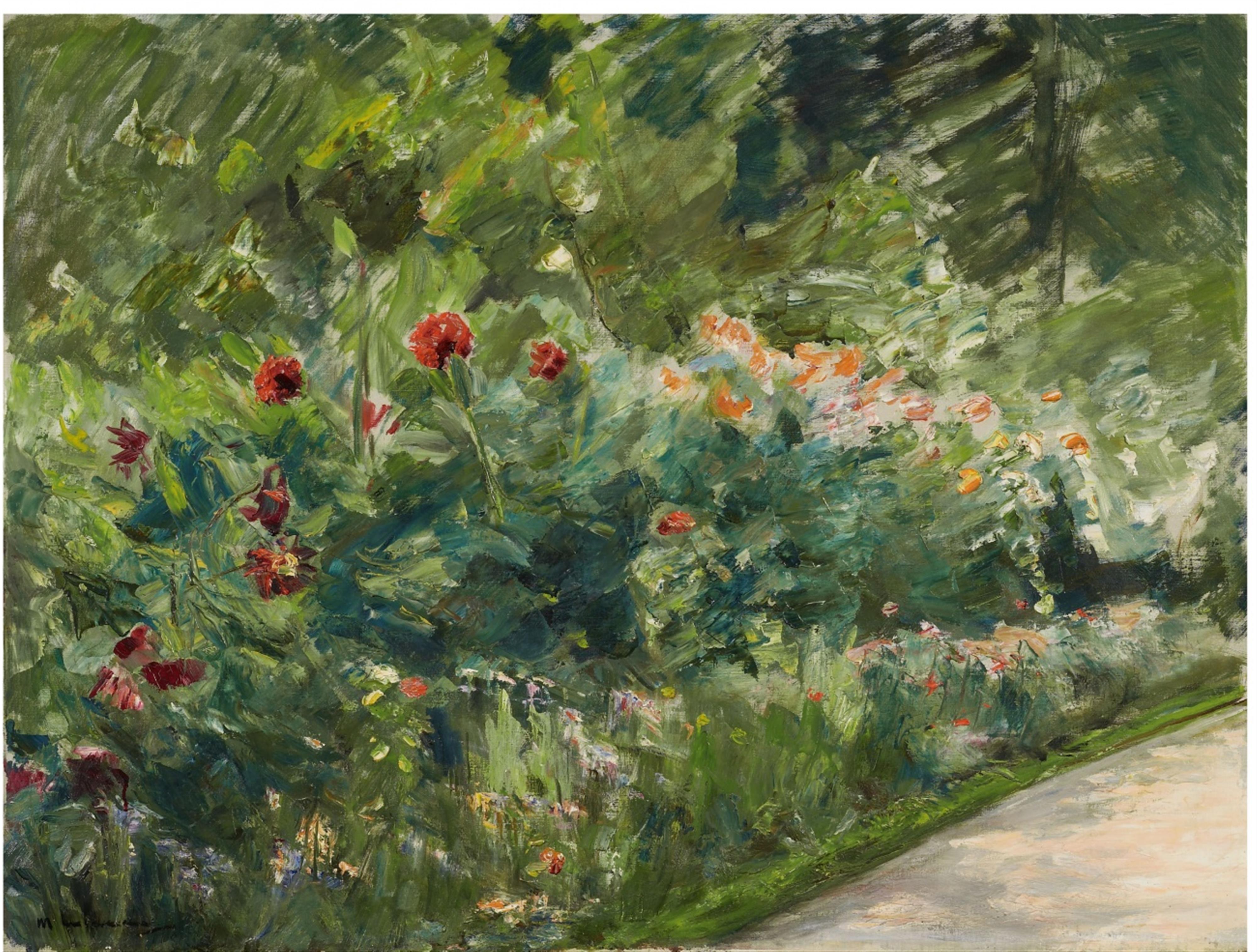Max Liebermann
Blumenstauden im Nutzgarten nach Südwesten
1926
Oil on canvas 71.5 x 94.5 cm Framed. Signed 'M Liebermann' in black lower left.
In 1909 Max Liebermann purchased a property on the shore of the Großer Wannsee and commissioned the architect Paul Baumgarten to build a two-storey country house in the middle of the elongated property. He discussed the design of the garden with his friend Alfred Lichtwark, the director of the Hamburger Kunsthalle. An extensive exchange of letters between the artist and the art historian documents the museologist's intense occupation with historical models of garden design, taking into account the needs of the painter and his family.
A flower and kitchen garden was set up in the front, towards the street; behind the house, on the piece of land leading to the water, sections of lawn alternate with hedge gardens suggestive of perspectival backdrops and freely placed birch trees. The numerous paintings that Liebermann then began to create with his garden as their motif allow us to grasp the different areas of the garden and, in addition to the splendour of their colours, they are also documents of a state that is no longer preserved today, but has been partially reconstructed.
Liebermann painted his garden for more than two decades and, from the very beginning, this created a new facet alongside the well-known subjects in his extensive oeuvre. As the structures of the garden, its arrangement between paths and beds, became more familiar to the artist and the plants grew more luxuriant, his painterly perspective on this place of tranquillity far from the metropolis of Berlin became all the more free and light. Whereas Liebermann's characteristic brushstroke based on French Impressionism still predominated in the 'portraits' of the garden landscape created at the beginning, the artist increasingly liberated himself from the strict order of the landscaped garden in the mid-1920s and literally cast his view to the side - in the image here, towards the border of perennial flowers in front of a dense, green, wooded background. He not only changed his perspective in this way, he also changed to an almost Fauvist palette of colours and brushstrokes. More or less broad strokes of the brush alternate green in green, and they grow into an opaque wall; in front of it stand luxuriantly upright stems topped with dark red and orange flowers, rising in tiers above a broad bed at the edge of a path almost entirely cut off by the painting's edges. With a cleanly manicured edge, it leads diagonally to the right, investing the entire motif with a certain directionality and 'earthing', so to speak. At the peak of his abilities, Liebermann pursues traditional landscape painting with pristine nature in a virtuoso manner. This free unfolding of nature seems like a liberation from an academic order personified not least by Liebermann himself, who had served as a strict juror for years. As a studio, the Wannsee garden offered Liebermann a welcome change of pace from his home and studio next to Pariser Platz, directly adjacent to the Brandenburg Gate and diagonally opposite the Akademie der bildenden Künste, where society guests were received and sometimes portrayed. The Wannsee garden and the more than one hundred paintings created there document the path that brought the artist closer to the wild growth of nature, which he entered - so to speak - with this 'portrait' of the perennial flowers.
Catalogue Raisonné
Eberle 1926/15
Provenance
Formerly private possession, USA; Collection S., Zurich (1959); Galerie Grosshennig, Düsseldorf (1960); Rhenish private collection
Literature
Hans Rosenhagen, Max Liebermann, Bielefeld-Leipzig 1927 (2. neubearbeitete Auflage), with colour illus. 80; Weltkunst, yr. XXX, 1960, no. 4 with illus. p. 31 (Galerieanzeige von Grosshennig); Holly Prentiss Richardson, Landscape in the work of Max Liebermann, Phil.Diss. Brown University, Ann Arbor 1991, vol. II, p. 263, no. 754
Exhibitions
Cologne 1959, 458. Lempertz'sche Kunstversteigerung, Kunst des XX. Jahrhunderts, 5.12. 1959, no. 161 with illus. pl. 11; Düsseldorf 1960 (Galerie Grosshennig), Meisterwerke der Malerei und Plastik des 19. Jahrhunderts, n. pag. with illus.; Bonn 2011 (Kunst- und Ausstellungshalle der Bundesrepublik Deutschland), Max Liebermann. Wegbereiter der Moderne, cat. no. 134 with colour illus.

